MonkeyTrail: A scalable video-based method for tracking macaque movement trajectory in daily living cages
Meng-Shi Liu, Jin-Quan Gao, Gu-Yue Hu,&, Guang-Fu Hao, Tian-Zi Jiang,6, Chen Zhang, Shan Yu,*
1 Brainnetome Center, Institute of Automation, Chinese Academy of Sciences, Beijing 100190, China
2 National Laboratory of Pattern Recognition, Institute of Automation, Chinese Academy of Sciences, Beijing 100190, China
3 School of Artificial Intelligence, University of Chinese Academy of Sciences, Beijing 101408, China
4 Technology Management Center, SAFE Pharmaceutical Technology Co., Ltd., Beijing 100176, China
5 Model R&D Center, Beijing Life Biosciences Co., Ltd., Beijing 100176, China
6 Key Laboratory for NeuroInformation of Ministry of Education, School of Life Science and Technology, University of Electronic Science and Technology of China, Chengdu, Sichuan 611731, China
7 Department of Neurobiology, School of Basic Medical Sciences, Beijing Key Laboratory of Neural Regeneration and Repair, and Advanced Innovation Center for Human Brain Protection, Capital Medical University, Beijing 100069, China
ABSTRACT Behavioral analysis of macaques provides important experimental evidence in the field of neuroscience.In recent years, video-based automatic animal behavior analysis has received widespread attention.However, methods capable of extracting and analyzing daily movement trajectories of macaques in their daily living cages remain underdeveloped,with previous approaches usually requiring specific environments to reduce interference from occlusion or environmental change.Here, we introduce a novel method, called MonkeyTrail, which satisfies the above requirements by frequently generating virtual empty backgrounds and using background subtraction to accurately obtain the foreground of moving animals.The empty background is generated by combining the frame difference method (FDM)and deep learning-based model (YOLOv5).The entire setup can be operated with low-cost hardware and can be applied to the daily living environments of individually caged macaques.To test MonkeyTrail performance, we labeled a dataset containing >8 000 video frames with the bounding boxes of macaques under various conditions as ground-truth.Results showed that the tracking accuracy and stability of MonkeyTrail exceeded that of two deep learningbased methods (YOLOv5 and Single-Shot MultiBox Detector), traditional frame difference method, and na?ve background subtraction method.Using MonkeyTrail to analyze long-term surveillance videorecordings, we successfully assessed changes in animal behavior in terms of movement amount and spatial preference.Thus, these findings demonstrate that MonkeyTrail enables low-cost, large-scale daily behavioral analysis of macaques.
Keywords: Movement trajectory tracking; Videobased behavioral analyses; Background subtraction; Virtual empty background; Occlusion
INTRODUCTION
Due to their similarity to humans in terms of genetics,physiology, behaviors, and structural/functional characteristics of the brain (Gibbs et al., 2007), macaques are widely used as an effective animal model to study human brain disorders,such as Parkinson’s disease (Bezard et al., 2001), Alzheimer’s disease (Beckman & Morrison, 2021), autism spectrum disorders (Liu et al., 2016b), and Rett syndrome (Chen et al.,2017).In these studies, behavioral analyses provide important information for validating models and developing effective treatments (Krakauer et al., 2017; Lehner, 1987; Nice, 1954).However, traditional behavioral analyses conducted by human experimenters are both time-consuming and susceptible to subjective biases (Bateson & Martin, 2021).More importantly,behavioral parameters that can be analyzed manually are very limited.Thus, automatic methods for behavioral analysis have attracted increasing attention in recent years.Among them,video-based methods built on rapid technological developments in computer vision have become promising approaches (Mathis et al., 2020).
Video-based automatic analysis of macaque behavior usually involves measurement of movement amount(quantifying overall movement intensity) (Caiola et al., 2019;Hashimoto et al., 1999; Togasaki et al., 2005; Yabumoto et al.,2019), movement trajectory (measuring trajectory of body during movements) (Bala et al., 2020; Francisco et al., 2019;Graving et al., 2019; Lind et al., 2005; Mathis et al., 2018;Ueno et al., 2019; Walton et al., 2006; Yabumoto et al., 2019;Yao et al., 2019), and behavioral categorization (categorizing different types of activities) (Ballesta et al., 2014; Hu et al.,2020a, 2020b; Wiltschko et al., 2015).Movement trajectory can provide vital information for various purposes.Movement trajectory length not only reflects overall activity level, but also records important spatial information about movement(Yabumoto et al., 2019), which can be used to categorize different behaviors for quantifying movement characteristics specific to Parkinson’s disease, drunkenness, and aging(Caiola et al., 2019; Liu et al., 2016b; Pandya et al., 2015;Togasaki et al., 2005; Walton et al., 2006; Yabumoto et al.,2019).Due to its wide applications, video-based trajectory tracking has been actively developed in recent years and can be divided into methods based on traditional image processing(Lind et al., 2005; Walton et al., 2006; Yabumoto et al., 2019)and on deep learning (Bala et al., 2020; Francisco et al., 2019;Graving et al., 2019; Mathis et al., 2018; Ueno et al., 2019;Yao et al., 2019).
Background subtraction is an essential technique used in traditional video-based trajectory tracking (Lind et al., 2005;Walton et al., 2006; Yabumoto et al., 2019), which considers the animal as the foreground and assumes the background is stable.Thus, subtracting the background from individual frames can highlight the animal.If the contrast between the selected background and animal is high, background subtraction can achieve accurate tracking (Walton et al.,2006).Compared with deep learning-based methods,background subtraction does not need to learn features of the animal, and thus needs no model training (Bala et al., 2020;Yao et al., 2019).However, background subtraction is very sensitive to environmental changes in the video.Many background subtraction-based tracking methods require specific environments (Walton et al., 2006; Yabumoto et al.,2019) to provide a clean and stable background, e.g., using specialized cages made of transparent material (Ueno et al.,2019).These special requirements have prevented the wide use of automatic tracking of animals in daily living environments.
Deep learning-based trajectory tracking methods have capitalized on the rapid development in deep neural networks.Powerful tracking applications (Graving et al., 2019; Mathis et al., 2018) have been introduced in the field of animal motion tracking in recent years.Most tracking key points (Bala et al.,2020; Graving et al., 2019; Mathis et al., 2018; Yao et al.,2019) are based on pose estimation or track the whole animal(Francisco et al., 2019; Ueno et al., 2019) using object detection models.High-dimensional motion information can be obtained by recording the trajectory of key points (Johansson,1973).However, pose estimation is sensitive to occlusion.Although object detection models, such as YOLOv5 (Jocher,2021; Redmon et al., 2016) and Single-Shot MultiBox Detector(SSD) (Liu et al., 2016a), can alleviate the problem of occlusion, they fail under severely occluded conditions, e.g.,when macaques are behind dense mesh.The daily living cages of macaques contain bars, mesh, and other objects(e.g., water bottle, food box), which creates many occlusions for cameras outside the cage.To solve this issue, specific environments with less occlusion are also needed for deep learning-based methods (Bala et al., 2020; Caiola et al., 2019;Graving et al., 2019; Yao et al., 2019), thus creating the same problems as traditional methods.In addition, deep learningbased methods require a large amount of labeled data to train the model (Mathis et al., 2020), which is difficult to obtain for individual applications (Mathis et al., 2018), especially for animals with complex gestures such as macaques (Bala et al.,2020).
Despite significant progress in video-based animal trajectory tracking, important challenges still exist.A low-cost tracking method that can be efficiently applied to normal living environments is highly desirable.Here, we developed an effective method, MonkeyTrail, for tracking macaque body trajectory.The system only requires normal surveillance cameras mounted outside the cage.Furthermore, it needs no special environment and only requires a small amount of data for training.This method provides a low-cost, scalable solution to accurately track body movements of macaques in their daily living cages.
MATERIALS AND METHODS
Animals and recording environment
This study was conducted according to the international standards of non-human primate care and use and was approved by the Institutional Review Board/Ethics Committee of Capital Medical University (AEEI-2019-077).The monkeys were housed in animal rooms under a temperature of 18-26 °C and humidity of 40%-70%.Video data of three adult macaques in their daily living cages were used to develop and validate the tracking method.The macaques were provided with water, certified primate biscuits, vegetables and fruit daily.The animals were individually housed in cages adjacent to each other.The room was maintained on two light/dark cycles:12 h light/dark or 11.5 h light/12.5 h dark.A regular highdefinition (HD) surveillance camera (1 920×1 080 pixels, 25 Hz refresh rate, 4 mm focal length) was mounted on the other side of the room above the height of the cages.This setup ensured minimal disturbance to the normal living environment.However, it introduced technical challenges for automatic video tracking, including occlusion due to the metal bars and mesh of the cage and variable background due to movable objects, e.g., toys and pull-out plates, which needed to be overcome in this study.The overall recording environment and camera setup are shown in Figure 1.

Figure 1 Overall recording environment and camera setup
Overall workflow of MonkeyTrail
We devised a Python-based program called MonkeyTrail,which uses background subtraction supplemented with YOLOv5 to record the trajectory of individually caged macaques in their daily living environment.The major steps involved in the procedure are briefly described below.
In MonkeyTrail, video preprocessing first establishes parameters for the algorithm, automatically crops the video size, and sets the frame rate for video data.Next, a virtual empty background is generated by combining the frame difference method (FDM) and YOLOv5.The bounding boxes are then located using background subtraction with the generated empty backgrounds and simple image processing techniques.Finally, the centers of the bounding boxes in individual frames are connected to each other, producing a moving trajectory.The length of the trajectory is used to calculate the total amount of movements.The MonkeyTrail workflow is shown in Figure 2.

Figure 2 MonkeyTrail workflow
The source code of MonkeyTrail is available at https://github.com/Xingheliu/MonkeyTrail.
Video preprocessing
First, the region of interest in the first video frame is manually selected, which includes a single cage housing a macaque,and then the frames per second (fps) are set for further analyses.After all parameters are obtained, MonkeyTrail will automatically crop the video size and set the fps.This step eliminates irrelevant pixels from the videos to facilitate downstream processing and avoid interference from other animals.According to the first frame of each video, the initial tracking frame of the macaque and the center point of the cage are manually selected.The following steps are automatic.
Empty background generation
A key step in MonkeyTrail is to automatically update the empty background so that the background subtraction method (BSM)can be used for the cages.The generation of an empty background can be divided into two steps: (1) screening frames with high movements in the video sequence into two sets (L and R, representing frames with animal located in the left and right half of the cage, respectively); and (2) selecting the closest pair of L and R frames in a time sequence, and stitching together each empty area without macaques to form a complete empty background.
In the first step, FDM is used to initially obtain the L and R sets, with YOLOv5 then used to obtain reliable L and R sets.Specifically, there are three sub-steps: (1) The frame pixel difference is obtained using FDM.The amount of pixel difference can provide rough estimations of animal movement.At the same time, the position of pixel differences can provide the approximate position of the bounding box for the animal.(2) As the tracking position obtained by FDM will be more reliable when the animal is actively moving, a high-movement threshold (i.e., pixel difference threshold) is used to select frames in the video sequence and classify the frames into L and R sets based on the position of the bounding box.(3) YOLOv5 is then used to detect the L and R sets obtained in the previous step, and only preserve frames with a highconfidence bounding box.
In the second step, two suitable frames in the L and R sets are used to generate an empty background.This process involves two sub-steps: (1) To improve empty background quality, two frames are selected in the L and R sets with a high degree of location discrimination between tracking boxes.The latter criterion ensures that in these frames, the animal is on one side of the cage and the other side represents a halfempty background.(2) The L and R half-empty backgrounds are then spliced to provide a complete empty background.After successfully splicing multiple pairs of L and R frames, a series of automatically generated empty backgrounds are obtained.
Background subtraction in daily living cages
With frequently updated empty backgrounds, background subtraction combined with proper image processing will provide accurate bounding boxes of the macaques for tracking.Specifically, the original RGB-color frames are converted into gray scale, with the foreground then obtained by background subtraction.The extracted foreground is then subjected to standard image processing, including spatial median filtering, binarizing, eroding, and dilating (Gonzalez &Woods, 2002).The bounding box is formed by finding the minimal rectangular area that covers the foreground.
The parameters used for image processing in our program were optimized according to the experimental environment used.If applied to other environments, they can be adjusted appropriately to obtain the best results.In addition, to avoid over-processing the image under severe occlusion, which can result in excessive elimination of foreground results, previous FDM results are used to judge the size of the tracking frame.For example, if the foreground is too small and in a highdensity occlusion area, and if the FDM result is also in this area, then a bounding box with the same size as the immediate previous frame will be tracked.
Trajectory extraction and movement amount estimation
MonkeyTrail extracts trajectory by connecting the center point of the bounding boxes in consecutive frames, which can be used to reflect the center location of the macaque’s body.To reduce disturbance of the tracking point caused by subtle movements of the limbs or head, movements smaller than a preset threshold are discarded.In other words, when the Euclidean distance of the tracking point compared to the previous time point does not exceed this threshold, the change in the tracking point is filtered out.The distance of the trajectory represents the amount of movement.
Manually annotated test dataset
We created a test dataset to quantify the performance of MonkeyTrail in comparison to other methods.To test its reliability in various macaque movement states, the selected data included continuous movement, continuous stillness, and transition between movement and stillness.To test MonkeyTrail with different levels of occlusion, we selected data that included cases of macaques occluded by metal bars,mesh grids, and parts of their own body.Furthermore, the three monkeys used in the test dataset have different appearances, including size and fur coloring.None of the animals in the test dataset were present in the training set.Finally, to test MonkeyTrail performance across different lighting conditions, the dataset included both day and night video data.
The entire test dataset contained 55 min of video,composed of 13 consecutive clips of varying lengths to cover all conditions mentioned above.To reduce the workload of manual labeling, the frame rate was decreased to 2 or 5 fps,resulting in a total frame number of 8 130.We manually selected the bounding box containing the entire animal as ground-truth using the labeling platform LabelImg (Tzutalin,2015).
RESULTS
Updating empty background to detect monkeys in cages using background subtraction
Many methods using background subtraction to locate macaques in videos require a physically created empty background obtained by removing the animal from the monitoring environment.These empty backgrounds cannot be frequently updated.However, due to changes in the environment over time (e.g., cage movement, changes in lighting conditions, and introduction of new objects in the frame), the empty background obtained in advance will not match the true background over long periods of recording.
Typical changes in the background of a randomly chosen daily video recording (~2 h) are shown in Figure 3.The three sequentially generated (~1 h intervals) empty backgrounds of the same cage (Figure 3C-E) (see methods for details)showed that the background changed in brightness and detailed appearance.To highlight these changes, we used a video frame with the monkey in cage (Figure 3B) to perform background subtraction with frames showing in Figure 3C-E,in which Figure 3E is most close to the moment of Figure 3B.The background subtraction results are illustrated by the white pixels in Figure 3F-H.As seen in Figure 3H, background subtraction successfully highlighted the macaque, but using empty backgrounds obtained 1 or 2 h earlier resulted in lowquality outcomes (Figure 3F, G).Thus, the longer the time elapsed since obtaining the empty background, the poorer the subtraction results, making it more difficult to locate the foreground using image processing techniques.The above example illustrates the importance of frequently updating empty backgrounds to detect caged monkeys using background subtraction.
Application of YOLOv5 to generate empty background and visualize tracking results
To achieve better background subtraction, we introduced a method in MonkeyTrail to frequently update the empty background with minimal animal disturbance.Simply, wedetected the frames in which the animal was on one side of the cage, thus providing a half-empty background, and then spliced the left and right half-empty backgrounds adjacent to each other in time to generate a virtual empty background.
As seen in Figure 4, the L and R frame sets (Figure 4A)showed animals in the left and right halves of the cage,respectively.The L and R frames were first detected using FDM to roughly locate the animal in the frame, followed by the deep learning-based model of YOLOv5 to select frames with a high-confidence bounding box.Two frames (Figure 4B) from the L and R set close in time were then paired.Finally, the areas where there were no macaques in the two frames were stitched together to generate a virtual empty background(Figure 4C).For more details, see section "Empty background generation" in Materials and Methods.

Figure 3 Influence of environmental changes on efficacy of background subtraction
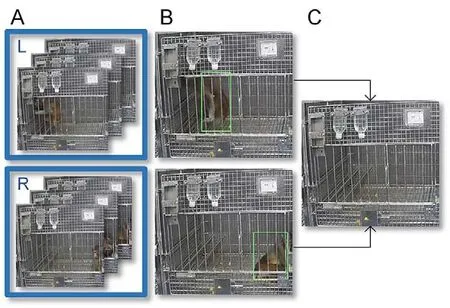
Figure 4 Method to frequently update empty background
With the frequently updated empty background, background subtraction showed good performance in highlighting foreground objects (cf.Figure 5A-C) using simple image processing techniques (see methods for details).
Thus, based on the extracted foreground containing the animal, the bounding box and movement trajectory can be easily obtained.Furthermore, MonkeyTrail can provide bounding boxes reasonably fit to the trunk of the monkey under various occlusion and lighting conditions (day and night)(Figure 6; Supplementary Videos S1, S2).
Accuracy of MonkeyTrail in generating bounding boxes
MonkeyTrail capitalizes on the combined strengths of BSM,FDM, and YOLOv5.Thus, we next quantitatively analyzed the improvements in MonkeyTrail over these three methods and the deep learning model SSD.We prepared a manually annotated dataset to obtain the ground-truth (see Materials and Methods for details), and then compared the MonkeyTrail,BSM, FDM, YOLOv5, and SSD results.To provide a comprehensive comparison, the testing dataset contained 13 video clips from three animals, covering various movement modes, occlusions, and lighting conditions (day and night).To facilitate fair comparison, the FDM, BSM, YOLOv5, and SSD processes were the same as the corresponding functions in MonkeyTrail.For example, image processing in BSM without an updated background is the same as MonkeyTrail, and the YOLOv5 model for object detection is the same as that used by MonkeyTrail.Tracking accuracy was determined by IoU,which measures the degree of overlap between the bounding box generated by individual methods (rt) and that of the ground-truth (ro), and is defined as:

To visualize the tracking results of different methods, we displayed the IoU value for each frame in the test dataset with a continuous time axis, as shown in Figure 7A-E.To better understand how animal activity and occlusions can affect the different methods, we plotted the estimated amount of total activity, as well as the period in which the animals were severely occluded, as shown in Figure 7F.
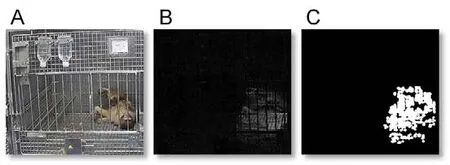
Figure 5 Background subtraction process with generated empty background
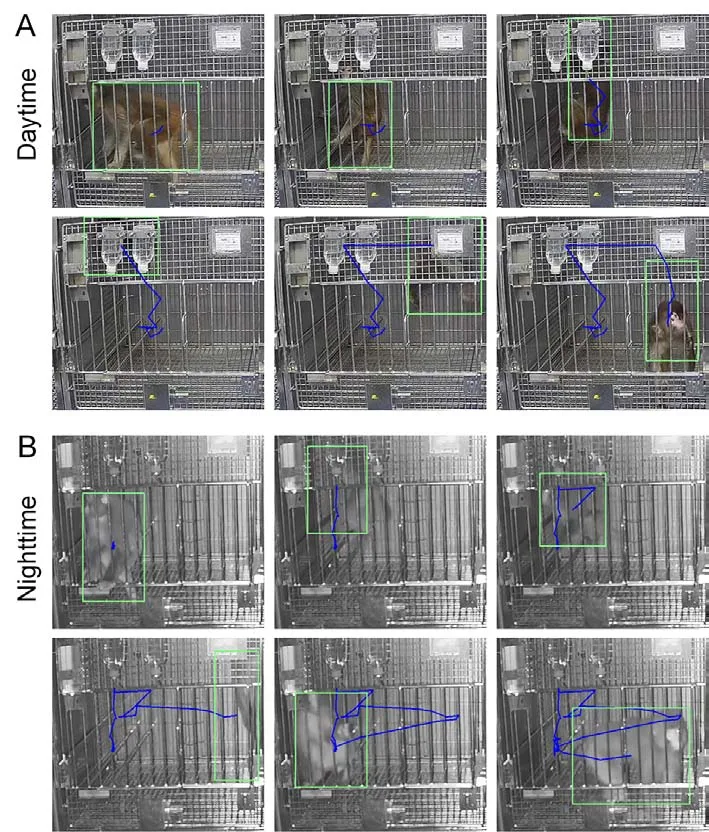
Figure 6 Representative tracking results for macaque during daytime and nighttime
Among the methods, MonkeyTrail provided the most accurate and stable tracking results, reflected by overall larger IoU values and smaller variability (Figure 7A).In comparison,both SSD and YOLOv5 showed highly fluctuating performance(Figure 7B, C), with reasonable tracking results interrupted by periods of zero IoU, indicating failure to detect the animal at all(Figure 7B, C).Importantly, these failures usually occurred when the animals were occluded (cf.Figure 7F), suggesting that SSD and YOLOv5 are highly sensitive to occlusion.Without frequently updating the empty background, traditional BSM exhibited noisy results.Thus, it was difficult to obtain accurate macaque foreground areas by standard image processing, leading to inaccurate tracking results (Figure 7D).In addition, FDM provided relatively accurate tracking results,but only when the animals were actively moving (Figure 7E, cf.Figure 7E).These analyses provide insights into the advantages and disadvantages of different methods and illustrate how MonkeyTrail can combine their strengths to achieve accurate and stable tracking.
To provide a more comprehensive and quantitative comparison, we compared tracking success rates with a systematically varying overlap threshold, which is often used for gauging the performance of object tracking methods (Wu et al., 2013).The results are shown in Figure 8.When the“overlap threshold” of a certain frame was greater than the set threshold, the frame was regarded as a success, and the percentage of total successful frames in all frames was defined as the “success rate”.Compared with SSD, BSM, and FDM, the success rate of MonkeyTrail was consistently higher over the entire overlap threshold range.Although YOLOv5 seemed to be more accurate in a small proportion of frames, it failed to detect monkeys completely in ~15% of frames; in contrast, MonkeyTrail exhibited more stable tracking results,yielding more favorable overall performance.
Application of MonkeyTrail to extract movement patterns in daily living cages
To demonstrate the practical value of our method in analyzing the behaviors of macaques, we used the trajectories recorded by MonkeyTrail to calculate the amount of movement and spatial preference of two macaques over two time periods separated by one year, each containing recordings of five consecutive days.Movement amount and spatial preference are useful indicators of behavioral changes induced by factors such as drug injection, surgery, and changes in external conditions (Caiola et al., 2019; Togasaki et al., 2005;Yabumoto et al., 2019).Daily monitoring of these parameters can reveal their acute and chronic effects on behavior.
Total activity is shown in Figure 9.In addition to the obvious results that sleep-awake cycles affect activity patterns,monkeys in the 2019 recordings showed a bimodal pattern of active movement during the daytime in the cages, which may be the combined result of physiological (i.e., napping) and housekeeping (i.e., feeding, lighting) factors.In 2020, both the lighting schedule and housekeeping activity pattern changed.As a result, total amount of activity of animals changed to atrimodal pattern.These results illustrate the value of tracking total activity amount to capture behavioral changes in monkeys in daily living cages.Such changes not only reflectthe influence of unintentional external factors, as above, but also provide valuable information for validating intentional treatments, such as drug administration or surgical operations.
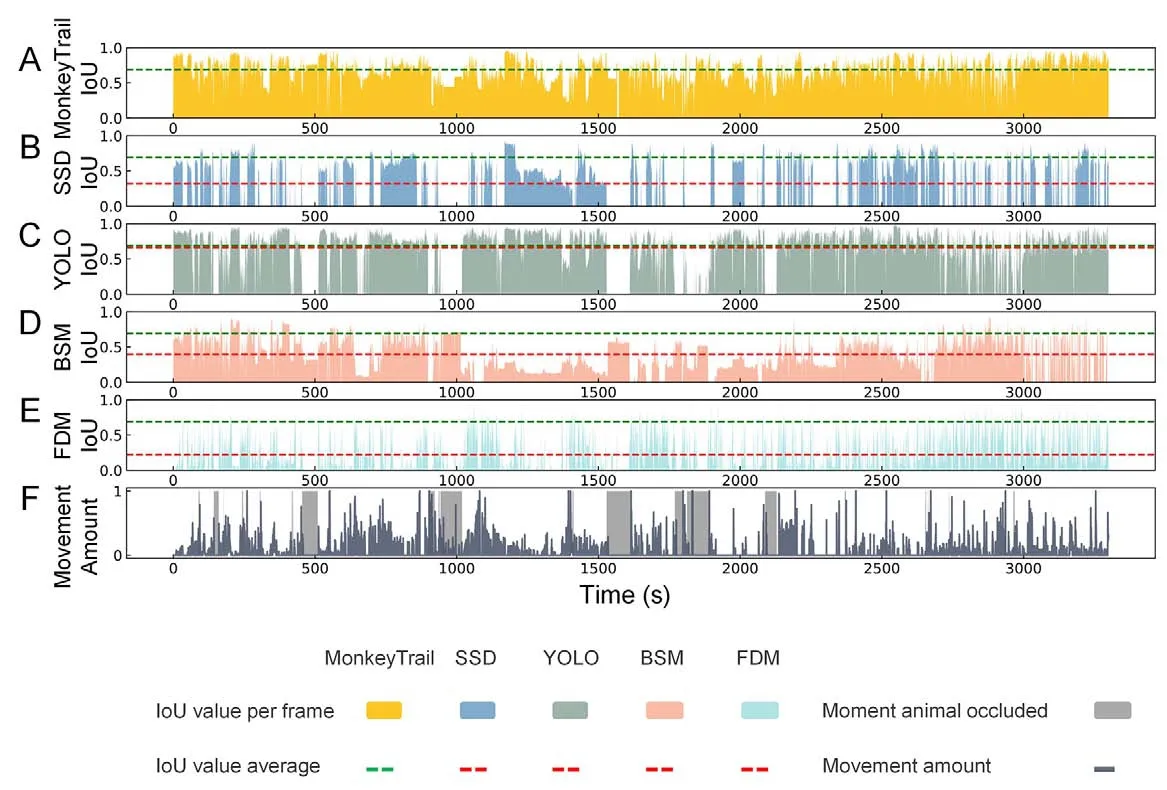
Figure 7 Visualization of performance in generating bounding boxes by different methods
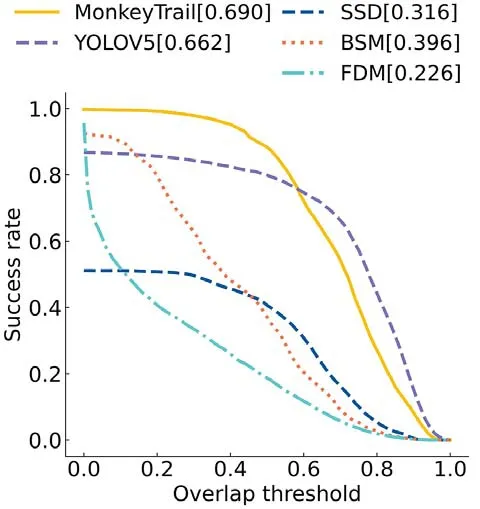
Figure 8 Tracking success rates with systematically varying overlap thresholds for different tracking methods
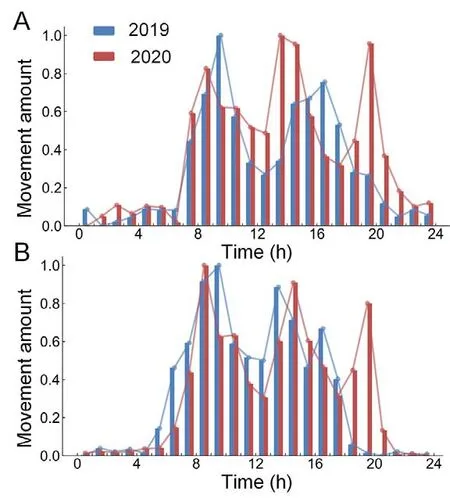
Figure 9 Daily total activity patterns of two monkeys (A and B)captured with MonkeyTrail
The spatial preferences are shown in Figure 10.We first divided the two-dimensional (2D) projection of the cage into 16 areas.We then counted the number of times the macaque’s trajectory passed through each area (normalized by the maximum number found in one area) to determine its spatial preferences.Similar to total activity amount, we analyzed the average spatial preferences of the macaques from 1100h to 1200h for five consecutive days in both 2019 and 2020.In 2019, monkey A showed a preference for hanging at the top of the cage (Figure 10A), while monkey B preferred to sit at the bottom of the cage (Figure 10C).A year later, monkey B still showed a preference for sitting on the base of the cage(Figure 10D), but monkey A had changed its behavioral preference, more often sitting than hanging (Figure 10B).As shown in Figures 9, 10, tracking animal behavior in their daily living cages can provide useful information regarding movement patterns in both temporal and spatial domains.
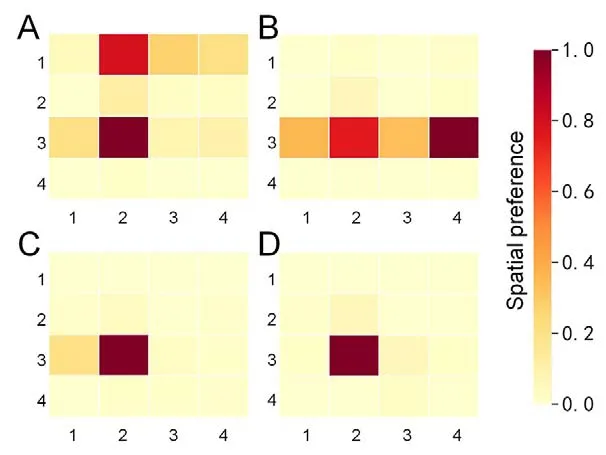
Figure 10 Spatial preference of macaques extracted by MonkeyTrail
DISCUSSION
In this study, we introduced a simple method named MonkeyTrail to track the movement trajectories of macaques.MonkeyTrail is based on frequently updating the empty background to apply background subtraction effectively and accurately for analyzing videos recorded outside animal cages.To the best of our knowledge, due to its minimal recording environment and hardware requirements,MonkeyTrail is the first method that can be deployed in parallel to monitor many monkeys in their daily living cages.
Several limitations are worth noting.Firstly, this method does not include steps to eliminate image distortion due to different viewing angles, therefore we recommend that the camera be mounted directly opposite the cage of interest.Secondly, if an animal remains at one side of the cage for a prolonged period, it can be difficult to generate a virtual empty background, which may impact tracking accuracy.However,our empirical data showed that, on average, updating the background once every 40 min showed reasonably good results, thus providing an ample time window to generate multiple virtual empty backgrounds.Thirdly, our method is primarily designed for individually caged animals.Although it can be used to track multiple macaques in the same cage as long as they are spatially separated, the method cannot be readily extended to situations in which multiple animals interact with each other.
Movement trajectories extracted by MonkeyTrail can be used to analyze spatial preference and movement amount.Compared with motion recorded by pixel differences (Caiola et al., 2019; Hashimoto et al., 1999), motion calculated by the distance of trajectory, although not suited to detect subtle movements of small body parts, can provide more accurate results at the whole-body movement level, especially under conditions with severe occlusion.Trajectory also provides spatial information, which is missing in pixel differences.Although posture estimation can be used to analyze more detailed movement patterns, overall movement trajectory of animals can still provide important information.For example,Pandya et al.(2015) verified the relationship between mitochondrial aging and age-dependent motor function loss by analyzing changes in distance and speed of movement of different-aged macaques, which directly supported the mitochondrial aging theory.Yabumoto et al.(2019) analyzed changes in spatial patterns of movement trajectory in macaques before and after alcohol injection, thus revealing the effects of alcohol in movement control.Liu et al.(2016b)recorded the locomotion trajectory of monkeys in cages and found anxiety-associated behaviors, e.g., repetitive, circular locomotion, in animals with MeCP2 overexpression, mimicking autism spectrum disorders in humans.
In addition to extracting movement trajectories, MonkeyTrail can also provide outlines of animals for individual frames, with either bounding boxes or body masks, which may be instrumental for future algorithms aimed at pose detection.In addition, the bounding boxes and their contents provided by MonkeyTrail can serve as training samples to train or fine-tune other deep learning-based methods for more sophisticated detection and recognition.
MonkeyTrail uses long-term video recordings of macaques in their daily living cages using ordinary HD cameras mounted outside the cage.This low-cost setup is scalable to automatically track many animals, thus allowing large-scale applications.In addition to behavioral tracking in future experiments, our method can also be used to analyze stored data retrospectively for animal rooms equipped with video recording devices.Furthermore, this method can be readily extended to three-dimensional (3D) tracking with depth cameras (Yabumoto et al., 2019), thus providing more comprehensive information regarding the movement patterns of animals.
SUPPLEMENTARY DATA
Supplementary data to this article can be found online(Supplementary Video S1, S2).
COMPETING INTERESTS
The Institute of Automation, Chinese Academy of Sciences has submitted patent application on the methods described in this paper (application No.2021116673622; invented by M.S.L and S.Y.; pending).
AUTHORS’ CONTRIBUTIONS
M.S.L., C.Z., J.Q.G., T.Z.J., and S.Y.designed the experiments.C.Z.and J.Q.G.provided the original video data.M.S.L.developed the algorithm.M.S.L., G.Y.H., G.F.H.,M.S.L., and S.Y.wrote the manuscript.All authors read and approved the final version of the manuscript.
- Zoological Research的其它文章
- Mechanism of hyperproteinemia-induced blood cell homeostasis imbalance in an animal model
- Identification of global alternative splicing and sexspecific splicing via comparative transcriptome analysis of gonads of Chinese tongue sole (Cynoglossus semilaevis)
- Phylogenetic relationships of the zokor genus Eospalax(Mammalia, Rodentia, Spalacidae) inferred from wholegenome analyses, with description of a new species endemic to Hengduan Mountains
- Unknown species from China: The case of phrurolithid spiders (Araneae, Phrurolithidae)
- A new species of the gudgeon genus Microphysogobio Mori, 1934 (Cypriniformes: Cyprinidae) from Zhejiang Province, China
- High-quality chromosome-level genome assembly of Tibetan fox (Vulpes ferrilata)

